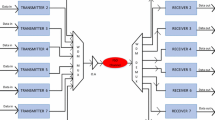Abstract
Free space optics (FSO) has the capacity to be a vital element for the design of ubiquitous and reliable systems for next-generation networks owing to its large bandwidth and high data rate support. The last-mile issue finds an efficient solution in FSO in scenarios where fiber deployment is not feasible. However the FSO link is prone to fluctuations in optical signal strength due to various weather conditions and atmospheric turbulence. In this paper, an 80 (8 × 10) Gbps RZ-DPSK based WDM-FSO system is analyzed based on its performance on weather conditions viz. very clear, drizzle, haze, thin fog, moderate fog and thick fog. Link-margin analysis is also done. The turbulence model employed is the Gamma–Gamma fading model. The system is simulated on OptiSystem 14.0.







Similar content being viewed by others
References
Badar, N., Jha, R.K.: Performance comparison of various modulation schemes over free space optical (FSO) link employing Gamma–Gamma fading model. Opt. Quant. Electron. 49, 192 (2017)
Bloom, S., et al.: Understanding the performance of free space optics. J. Opt. Netw. 2(6), 178–200 (2003)
David, F.: Scintillation loss in free-space optic im/dd systems. In: LASE 2004, vol. 5338. San Jose (USA) (2004)
Fadhil, H.A., et al.: Optimization of free space optics parameters: an optimum solution for bad weather conditions. Optik—Int. J. Light Electron Opt. 124(19), 3969–3973 (2013)
Gappmair, W., Flohberger, M.: Error performance of coded FSO links in turbulent atmosphere modeled by Gamma–Gamma distribution. IEEE Trans. Wireless Commun. 8(5), 2209–2213 (2009)
Gnauck, A.H., Winzer, P.J.: Optical phase-shift-keyed transmission. J. Lightwave Technol. 23, 115–130 (2005)
Guodong, X., et al.: Effects of atmosphere dominated phase fluctuation and intensity scintillation to DPSK system. In: IEEE International Conference on Communication (ICC), pp. 1–6 (2011)
Khalighi, M.A., Uysal, M.: Survey on free space optical communication: a communication theory perspective. IEEE Commun. Surv. Tutor. 16(4), 2231–2258 (2014)
Kim, I.I., et al.: Comparison of laser beam propagation at 785 nm and 1550 nm in fog and haze for optical wireless communications. Proc. SPIE 4214, 26–37 (2001)
Larry, C.: Laser Beam Propagation Through Random Media, 2nd edn. SPIE Press Book, Bellingham (2005)
Letzepis, N., et al.: The Gaussian free space optical MIMO channel with Q-ary pulse position modulation. IEEE Trans. Wireless Commun. 7(5), 1744–1753 (2008)
Popoola, W.O., Ghassemlooy, Z.: BBPSK subcarrier intensity modulated free-space optical communications in atmospheric turbulence. J. Lightwave Technol. 27(8), 967–973 (2009)
Thakur, R., et al.: Review on free space optics. Int. J. Comput. Technol. 8(1), 734–742 (2013)
Acknowledgements
The authors gratefully acknowledge the support provided by 5G and IoT Lab, DoECE, and TBIC, Shri Mata Vaishno Devi University, Katra, Jammu.
Author information
Authors and Affiliations
Corresponding author
Rights and permissions
About this article
Cite this article
Badar, N., Jha, R.K. & Towfeeq, I. Performance analysis of an 80 (8 × 10) Gbps RZ-DPSK based WDM-FSO system under combined effects of various weather conditions and atmospheric turbulence induced fading employing Gamma–Gamma fading model. Opt Quant Electron 50, 44 (2018). https://doi.org/10.1007/s11082-017-1306-y
Received:
Accepted:
Published:
DOI: https://doi.org/10.1007/s11082-017-1306-y




